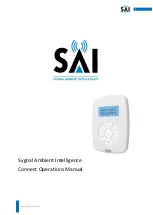
L-DALI User Manual
364
LOYTEC
Version 5.2
LOYTEC electronics GmbH
created. The item value of the tag is the string data, e.g., “Room4”. The OPC tag contains a
number of OPC properties, which are derived from the data point’s properties:
Item Canonical Data Type (SmallInt): This property indicates the data type ‘8’ (String).
Item Value (String): The string value.
Item Quality (SmallInt): The value quality. It is “good” if the data point is in normal
state, or “uncertain” if the data point has an off-normal state, e.g., offline or unreliable.
Item Timestamp (Date): This property contains the timestamp of the last value update.
Item Access Rights (Integer): This property defines whether the tag is read-only or
read/write.
Item Description (String): This is the description of the data point.
8.5.2.6 Structured Data Points
Structured data points are modeled as one user-type data point, which contains the entire
structure value as a byte array. The respective structure fields are created as sub-data points
of appropriate class.
The relation between user-type data point and sub-data points is also exposed to OPC. In
this case, an OPC node is created for the user-type data point. In that node, the sub-data
points are exposed as OPC tags. The entire structure is also exposed as a user-type OPC tag
under the same OPC node.
Important!
Deselect any un-used structure members from OPC exposure to reduce the number of
total OPC tags.
It is important to note, that when using structured data points the top-level and all its
structure members are exposed as OPC tags by default. Using many structured data points
may lead to exceeding the OPC tag limit. Please observe this limit in the Configurator’s
statistics tab and deselect the
OPC Tag
check box for unwanted structure members. This
helps to keep your configuration lean and improves the performance of the OPC server
when browsing and subscribing.
8.5.3 AST Objects
The alarming, scheduling, and trending (AST) objects are more complex than regular data
points. The OPC XML-DA standard does not have appropriate tags for those objects.
Therefore, the device exposes AST objects as a set of OPC tags describing the object. All
tags for one AST object are collected under an OPC node representing the AST object.
8.5.3.1 Scheduler Object
The device exposes the scheduler objects to OPC XML-DA tags. Each scheduler object is
represented by a node in the OPC name space. The content of the schedule XML document
referred to in this section must be compliant to the scheduleCfg schema. This schema can be
found at the LOYTEC Web site. The XML documents can refer to the target namespace
‘http://www.loytec.com/xsd/scheduleCfg/1.0/’.
In that node, the following OPC tags are available:
ServiceType (string, Read-only, const): This is a constant tag of type string, which
contains “schedule”. It identifies this folder as a schedule folder. This can be used as an
additional identification to the vendor-specific property of the folder tag.
















































